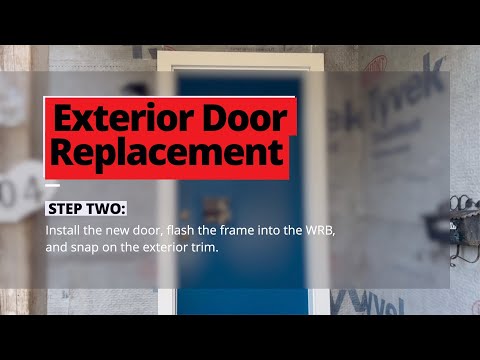The last time on ptc@home, we were grabbing TruExterior siding off the paint bench, carrying it around back, slapping it on the wall, and nailing it.
In this episode, I will replace the heavy wood front door whose sill isn’t deep enough to accommodate the extra thickness I added to the walls.
Replacement option: new high-performance entry door from Endura Products
One option would be to build out the door sill, but the easiest answer was to bring in a door sponsor for ptc@home, so that’s what we did.
Endura Products doesn’t make doors; they make all of the parts surrounding doors.
Like this FusionFrame rot-proof door jamb with built-in levels and tight weatherstripping. The wood frame has a composite base, where the vast majority of door frames fail.
Millwork shops assemble the door from the parts.
The actual door is metal with foam inside and double-glazed lites. This door was assembled at Cleary Millwork in Braintree, Massachusetts.
Prep the new entry door for installation
The first step of installing a new door is getting it delivered and checking that it will fit before removing the old door from the opening.
The next step is putting on your nail bags.
Before I remove the old door, though, I want to make sure the new one is ready to pop in the hole because it is still chilly outside.
If the door comes shipped with the trim already installed, remove the 2-piece jamb casings.
There is an outer casing and an inner fastening block that is a 2x2 wrapped in a 3-sided PVC sleeve that locks into the jamb.
Next, remove the jamb covers, which also snap into place. Be slow and careful.
This exposes the jambs with a built-in bubble level for plumbing the door in the opening and predrilled holes for screwing into the framing. [add callout pointing to hole]
The trim and jamb covers will be re-installed after the door is sitting plumb, level, and square.
Remove the old entry door
I popped out the old hinge pins and carried the door outside.
Rather than try to salvage the frame, I just cut through it with a Sawzall and pulled it out in pieces.
There was no water damage from previous leaks, probably because the door is so well sheltered, but there was no subfloor under the sill, so maybe all the water just leaked into my holiday decorations.
I pieced in the missing subfloor with some leftover ¾-in 1x6 sheathing making sure that the subfloor was level.
Prep the rough opening for entry door installation
Next, I checked the rough opening to see how far away from perfect it was. It turned out the jamb was about ⅜ of an inch away from perfect, so I fastened a ⅜ inch block to the bottom of the jamb, sealing it to the framing with adhesive caulk and nailing it in place.
Now I can screw the top and bottom of the jamb tight into the framing, and I will shim the center to snugness.
After adding a subfloor patch, I use Dupont’s FlexWrap to form a sill pan flashing. For more extreme exposure, I might use a preformed unit or bend one from coil stock.
There are multiple release sheets on the wide FlexWrap, and I remove the innermost one for positioning the flashing.
One good thing about working in chilly weather is that the tape doesn’t stick aggressively to the substrate immediately, so you have some wiggle room.
I remove the outer release layer and stick the flashing to the face of the Styrofoam behind the Drainvent rain screen. Next, I tool it into place with a plastic squeegee.
Now the opening is ready to receive the new door. And I’m going to install it in the next episode.
MORE IN THIS SERIES
- Part 2: Installing the exterior door and trim
- The whole series: ptc@home: Exterior Insulation Retrofit and Siding Replacement











